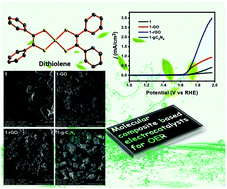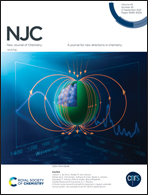Ni(ii) dithiolate anion composites with two-dimensional materials for electrochemical oxygen evolution reactions (OERs)†
Abstract
In this report, the composites of anionic complex [NEt4][Ni(S2C2Ph2)2] with two-dimensional materials such as graphene oxide (GO), reduced graphene oxide (rGO) or graphitic carbon nitride (g-C3N4) have been prepared by a simple sonochemical technique and utilized for the oxygen evolution half-cell reaction of water splitting. The synthesized complex anion has been characterized spectroscopically and by single-crystal X-ray diffraction, while its composites with GO, rGO and g-C3N4 have been characterized using physicochemical characterization techniques, viz. powder X-ray diffraction and scanning electron microscopy. Electrochemical measurements were performed on a three-electrode system having a platinum wire counter electrode, a Ag/AgCl reference electrode and a catalytically modified glassy carbon electrode using linear sweep voltammetry, cyclic voltammetry and electrochemical impedance spectroscopy. The electrochemical studies suggest that the [Ni(S2C2Ph2)2]-rGO modified electrode had notable electrocatalytic activity for the oxygen evolution reaction (OER). The fabricated electrode exhibited acceptable repeatability, reproducibility and stability. To the best of our knowledge, there are only a few reports on detailed studies of composites of 2D materials with a nickel-based molecular complex, exhibiting substantial synergistic activity towards electrochemical water splitting.



 Please wait while we load your content...
Please wait while we load your content...